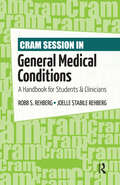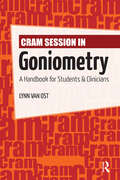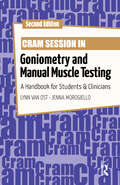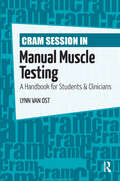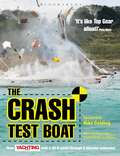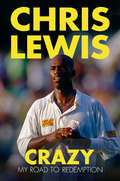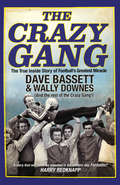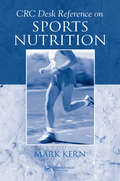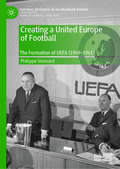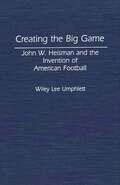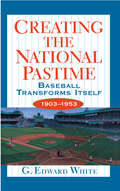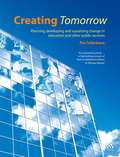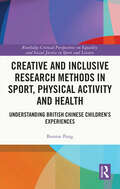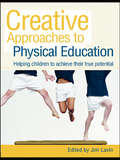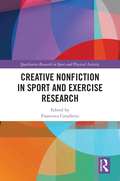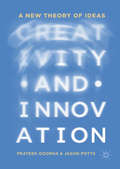- Table View
- List View
Cram Session in General Medical Conditions: A Handbook for Students and Clinicians
by Robb Rehberg Joelle RehbergAre you a rehabilitation professional or student in need of a basic understanding of general medical conditions? Supplemented by concise and user-friendly clinical information on the conditions, Cram Session in General Medical Conditions: A Handbook for Students & Clinicians is the perfect resource for quick and “at your fingertips” facts.Cram Session in General Medical Conditions: A Handbook for Students & Clinicians by Dr. Robb S. Rehberg and Dr. Joelle Stabile Rehberg is a succinct and descriptive quick reference that provides the rehabilitation professional with a very basic approach to understanding various general medical conditions. What is in your “Cram Session”:• Breakdown of each medical condition covered• Each condition includes the name of the condition, alternate names, description, causes, clinical presentation, symptoms, diagnosis, and management• Includes over 125 general medical conditions in over 13 categoriesCram Session in General Medical Conditions: A Handbook for Students & Clinicians is an informative, well-organized handbook for all students and clinicians in athletic training, physical therapy, occupational therapy, and orthopedics.
Cram Session in General Medical Conditions: A Handbook for Students and Clinicians
by Robb Rehberg Joelle RehbergAre you a rehabilitation professional or student in need of a basic understanding of general medical conditions? Supplemented by concise and user-friendly clinical information on the conditions, Cram Session in General Medical Conditions: A Handbook for Students & Clinicians is the perfect resource for quick and “at your fingertips” facts.Cram Session in General Medical Conditions: A Handbook for Students & Clinicians by Dr. Robb S. Rehberg and Dr. Joelle Stabile Rehberg is a succinct and descriptive quick reference that provides the rehabilitation professional with a very basic approach to understanding various general medical conditions. What is in your “Cram Session”:• Breakdown of each medical condition covered• Each condition includes the name of the condition, alternate names, description, causes, clinical presentation, symptoms, diagnosis, and management• Includes over 125 general medical conditions in over 13 categoriesCram Session in General Medical Conditions: A Handbook for Students & Clinicians is an informative, well-organized handbook for all students and clinicians in athletic training, physical therapy, occupational therapy, and orthopedics.
Cram Session in Goniometry: A Handbook for Students and Clinicians
by Lynn Van OstWhen all you need is a basic understanding of goniometry. When concise and illustrative examples of goniometric techniques will provide exactly what the rehabilitation professional needs—Look to Cram Session in Goniometry: A Handbook for Students and Clinicians for quick and “at your fingertips” facts.Cram Session in Goniometry by Lynn Van Ost is a concise and abundantly illustrated quick reference which provides the rehabilitation professional with a very basic approach to various goniometric techniques. Organized in a “head to toe” format, Cram Session in Goniometry takes user-friendly and efficient learning to a new level.What is in your “Cram Session”:• Photographs depicting each goniometric measurement• Breakdown of each body region covered• Each type of joint, capsular pattern, average range of motion, patient positioning, goniometric alignment, patient substitutions, and alternative methods of measurement• Over 190 photographsCram Session in Goniometry: A Handbook for Students and Clinicians is an informative, well-organized handbook for all students and clinicians in physical therapy, occupational therapy, athletic training and orthopedics.
Cram Session in Goniometry: A Handbook for Students and Clinicians
by Lynn Van OstWhen all you need is a basic understanding of goniometry. When concise and illustrative examples of goniometric techniques will provide exactly what the rehabilitation professional needs—Look to Cram Session in Goniometry: A Handbook for Students and Clinicians for quick and “at your fingertips” facts.Cram Session in Goniometry by Lynn Van Ost is a concise and abundantly illustrated quick reference which provides the rehabilitation professional with a very basic approach to various goniometric techniques. Organized in a “head to toe” format, Cram Session in Goniometry takes user-friendly and efficient learning to a new level.What is in your “Cram Session”:• Photographs depicting each goniometric measurement• Breakdown of each body region covered• Each type of joint, capsular pattern, average range of motion, patient positioning, goniometric alignment, patient substitutions, and alternative methods of measurement• Over 190 photographsCram Session in Goniometry: A Handbook for Students and Clinicians is an informative, well-organized handbook for all students and clinicians in physical therapy, occupational therapy, athletic training and orthopedics.
Cram Session in Goniometry and Manual Muscle Testing: A Handbook for Students and Clinicians
by Lynn Van Ost Jenna MorogielloNewly updated, Cram Session in Goniometry and Manual Muscle Testing: A Handbook for Students & Clinicians, Second Edition, is a descriptive quick reference guide for rehabilitation professionals organized in a “head-to-toe” format, including more than 400 photographs and supplemented with concise and illustrative examples of various techniques.The new edition of this text maintains the original essence of the first edition while touching upon updated information to speak to new clinicians. Minor revisions, such as adding color to the headers and to the sections, allow the reader easier access to the topics. An expanded appendix and up-to-date content touch on newer technology being used and developed in these areas of clinical evaluation.What is in your Cram Session: In the Goniometry section, subdivisions are broken down into type of joint, capsular pattern, average range of motion for each movement, patient positioning, goniometric alignment, patient substitutions, and alternative methods of measurement. In the Manual Muscle Testing section, subdivisions are broken into the specific movement to be tested, average range of motion, prime movers of the movement, secondary movers of the movement, anti-gravity patient position, gravity minimized patient position, stabilization and grades, substitutions for the movement, and points of interest for that particular muscle group. Cram Session in Goniometry and Manual Muscle Testing: A Handbook for Students & Clinicians, Second Edition, is an informative, well-organized handbook for all students, instructors, and clinicians in physical therapy, occupational therapy, athletic training, orthopedics, or any allied health professional who treats musculoskeletal disorders.
Cram Session in Goniometry and Manual Muscle Testing: A Handbook for Students and Clinicians
by Lynn Van Ost Jenna MorogielloNewly updated, Cram Session in Goniometry and Manual Muscle Testing: A Handbook for Students & Clinicians, Second Edition, is a descriptive quick reference guide for rehabilitation professionals organized in a “head-to-toe” format, including more than 400 photographs and supplemented with concise and illustrative examples of various techniques.The new edition of this text maintains the original essence of the first edition while touching upon updated information to speak to new clinicians. Minor revisions, such as adding color to the headers and to the sections, allow the reader easier access to the topics. An expanded appendix and up-to-date content touch on newer technology being used and developed in these areas of clinical evaluation.What is in your Cram Session: In the Goniometry section, subdivisions are broken down into type of joint, capsular pattern, average range of motion for each movement, patient positioning, goniometric alignment, patient substitutions, and alternative methods of measurement. In the Manual Muscle Testing section, subdivisions are broken into the specific movement to be tested, average range of motion, prime movers of the movement, secondary movers of the movement, anti-gravity patient position, gravity minimized patient position, stabilization and grades, substitutions for the movement, and points of interest for that particular muscle group. Cram Session in Goniometry and Manual Muscle Testing: A Handbook for Students & Clinicians, Second Edition, is an informative, well-organized handbook for all students, instructors, and clinicians in physical therapy, occupational therapy, athletic training, orthopedics, or any allied health professional who treats musculoskeletal disorders.
Cram Session in Manual Muscle Testing: A Handbook for Students and Clinicians
by Lynn Van OstWhen all you need is a basic understanding of manual muscle testing. When concise and illustrative examples of manual muscle testing techniques will provide exactly what the rehabilitation professional needs, look to Cram Session in Manual Muscle Testing: A Handbook for Students & Clinicians for quick and “at your fingertips” facts.Cram Session in Manual Muscle Testing: A Handbook for Students & Clinicians by Lynn Van Ost is a succinct and descriptive quick reference that provides the rehabilitation professional with a very basic approach to various manual muscle techniques. Organized in a “head to toe” format, Cram Session in Manual Muscle Testing: A Handbook for Students & Clinicians takes user-friendly and efficient learning to a new level.What is in your “Cram Session”:• Photographs depicting each manual muscle testing technique• Breakdown of each body region covered• Sections include average range of motion, prime movers, accessory muscles, patient positioning, muscle grading for each movement and substitutions• Over 200 photographsCram Session in Manual Muscle Testing: A Handbook for Students & Clinicians is an informative, well-organized handbook for all students and clinicians in physical therapy, occupational therapy, athletic training, orthopedics or any allied health professional who treats musculoskeletal disorders
Cram Session in Manual Muscle Testing: A Handbook for Students and Clinicians
by Lynn Van OstWhen all you need is a basic understanding of manual muscle testing. When concise and illustrative examples of manual muscle testing techniques will provide exactly what the rehabilitation professional needs, look to Cram Session in Manual Muscle Testing: A Handbook for Students & Clinicians for quick and “at your fingertips” facts.Cram Session in Manual Muscle Testing: A Handbook for Students & Clinicians by Lynn Van Ost is a succinct and descriptive quick reference that provides the rehabilitation professional with a very basic approach to various manual muscle techniques. Organized in a “head to toe” format, Cram Session in Manual Muscle Testing: A Handbook for Students & Clinicians takes user-friendly and efficient learning to a new level.What is in your “Cram Session”:• Photographs depicting each manual muscle testing technique• Breakdown of each body region covered• Sections include average range of motion, prime movers, accessory muscles, patient positioning, muscle grading for each movement and substitutions• Over 200 photographsCram Session in Manual Muscle Testing: A Handbook for Students & Clinicians is an informative, well-organized handbook for all students and clinicians in physical therapy, occupational therapy, athletic training, orthopedics or any allied health professional who treats musculoskeletal disorders
Crash Test Boat: How Yachting Monthly Took a 40ft Boat Through 8 Disaster Scenarios
by Paul GelderFrom the people behind the UK's leading sailing magazine for cruisers comes Crash Test Boat, a dramatic documentation of controlled sailing disasters which has the potential to save the lives of each and every seaman who buys it.Crash Test Boat is unique in its field, with no other title on the market aimed at explicitly revealing at first hand what happens when a boat encounters a major disaster. On the spot reporting with action photographs show what happens when typical family boats fall victim to eight different types of sailing disaster. How quickly does a cabin fill with water when the hull is holed? How do you control a gas leak or explosion? What should you do first when dealing with a dismasting?By providing cruising and racing yachtsmen with vivid accounts of such extreme events, Crash Test Boat equips the reader with vital knowledge on what to do if disaster strikes and, ultimately, gives everyone on board a greater chance of survival if the boat is overcome.
Crazy: My Road to Redemption
by Chris Lewis‘Crazy’ Chris Lewis played in thirty-two Test Matches and fifty-three One-Day Internationals for England. At one point he was regarded as one of the best all-round cricketers the country has ever produced. However, feeling at odds with the middle-class nature of the sport, he regularly courted controversy when off the field – and the tabloids happily lapped it up. His naming of England players involved in a match-fixing scandal led to his early retirement at the age of just 30. After this, he withdrew from the limelight until, in 2008, he was arrested for importing cocaine from the Caribbean and sentenced to thirteen years in prison. In Crazy, Lewis recounts his remarkable, redemptive story, from his arrival in England from Guyana, through his colourful cricketing career, his arrest and subsequent trial, his time in prison and how he finally put his life back together.
The Crazy Gang
by Dave Bassett Wally Downes'If we can sell Newcastle Brown to Japan, and if Wimbledon can make it to the First Division, there is surely no achievement beyond our reach.' Margaret ThatcherThe Crazy Gang is the story of a football miracle. Promoted to the Football League in 1977, Wimbledon FC was a small team from south London that against the odds went all the way to the top of the First Division, then to win the FA Cup, in only just over a decade. With no money, scant resources and a blend of youth players and offcuts from other clubs, they were christened 'Rag-Arse Rovers'. They played hard on the pitch and partied hard off it.Dave 'Harry' Bassett was the manager who drilled a fierce fighting spirit into his players, an unbreakable team ethos, but he was also an underrated master tactician and pioneer of innovative training methods. Wally Downes was the midfield fulcrum of the Dons, but also the ringleader for the various acts of debauchery and general silliness that earned the club their reputation.In The Crazy Gang, Harry and Wally are joined by a host of former Wimbledon players and staff, both famous names like Vinnie Jones, Lawrie Sanchez and Dave Beasant, but also unsung heroes in the club's history, to tell it as it really was. This is real football, the way fans remember it, and a world away from multimillionaire Premier League primadonnas.
CRC Desk Reference on Sports Nutrition
by Mark KernThe landscape of sports nutrition is dramatically altering, as those in search of optimal performance are moving the field from haphazard alchemy to exact science. Currently, thousands of products -- from ancient herbs and old standards to hormone extractions and test tube concoctions --compete for a place at the training table of both professional
CRC Desk Reference on Sports Nutrition
by Mark KernThe landscape of sports nutrition is dramatically altering, as those in search of optimal performance are moving the field from haphazard alchemy to exact science. Currently, thousands of products -- from ancient herbs and old standards to hormone extractions and test tube concoctions --compete for a place at the training table of both professional
Creating a United Europe of Football: The Formation of UEFA (1949–1961) (Football Research in an Enlarged Europe)
by Philippe VonnardThis book provides a historical study of the beginnings of the UEFA, demonstrating how the formation of the organisation was linked to the decentralisation experienced by FIFA, the world governing body of football. Vonnard examines why administrators created an association that transcended the barriers of the Cold War, and focused on the development of a network that promoted football outside the constraints of international politics. Finally, he emphasises the role UEFA played in the Europeanisation of the people’s game, and in the early years of the European integration process. The research is based on a rich body of new archival material from the UEFA and FIFA Documentation Centres, and various European football federations, as well as reports from a number of leading newspapers of the era, and interviews with football personalities of the 1950s. It will be of interest to students and scholars across the history of sport, international relations, and European studies
Creating the Big Game: John W. Heisman and the Invention of American Football (Contributions to the Study of Popular Culture)
by Wiley L. UmphlettJohn W. Heisman (1869-1936) was a man of many faces whose public image has suffered from a diffused, enigmatic, and mostly misunderstood private personality. Since his death the popular reception of the memorial trophy named in his honor has also obscured his identity. In singling out his many innovative contributions to the development of intercollegiate football, this book attempts to present a true picture of Heisman as both man and coach.Because he coached at schools throughout the country during some of the most eventful years in our history, Heisman's life relates to significant political, economic, and social developments that impacted on American society as well as sports. However, this book is much more than the story of John Heisman's 36-year coaching career. It is also the story of how an indigenous American public ritual--the Big Game---came about and how college football evolved into the complex, problematic, and highly structured big business that it is today.
Creating the National Pastime: Baseball Transforms Itself, 1903-1953
by G. Edward WhiteAt a time when many baseball fans wish for the game to return to a purer past, G. Edward White shows how seemingly irrational business decisions, inspired in part by the self-interest of the owners but also by their nostalgia for the game, transformed baseball into the national pastime. Not simply a professional sport, baseball has been treated as a focus of childhood rituals and an emblem of American individuality and fair play throughout much of the twentieth century. It started out, however, as a marginal urban sport associated with drinking and gambling. White describes its progression to an almost mythic status as an idyllic game, popular among people of all ages and classes. He then recounts the owner's efforts, often supported by the legal system, to preserve this image. Baseball grew up in the midst of urban industrialization during the Progressive Era, and the emerging steel and concrete baseball parks encapsulated feelings of neighborliness and associations with the rural leisure of bygone times. According to White, these nostalgic themes, together with personal financial concerns, guided owners toward practices that in retrospect appear unfair to players and detrimental to the progress of the game. Reserve clauses, blacklisting, and limiting franchise territories, for example, were meant to keep a consistent roster of players on a team, build fan loyalty, and maintain the game's local flavor. These practices also violated anti-trust laws and significantly restricted the economic power of the players. Owners vigorously fought against innovations, ranging from the night games and radio broadcasts to the inclusion of African-American players. Nonetheless, the image of baseball as a spirited civic endeavor persisted, even in the face of outright corruption, as witnessed in the courts' leniency toward the participants in the Black Sox scandal of 1919. White's story of baseball is intertwined with changes in technology and business in America and with changing attitudes toward race and ethnicity. The time is fast approaching, he concludes, when we must consider whether baseball is still regarded as the national pastime and whether protecting its image is worth the effort.
Creating the National Pastime: Baseball Transforms Itself, 1903-1953 (PDF)
by G. Edward WhiteAt a time when many baseball fans wish for the game to return to a purer past, G. Edward White shows how seemingly irrational business decisions, inspired in part by the self-interest of the owners but also by their nostalgia for the game, transformed baseball into the national pastime. Not simply a professional sport, baseball has been treated as a focus of childhood rituals and an emblem of American individuality and fair play throughout much of the twentieth century. It started out, however, as a marginal urban sport associated with drinking and gambling. White describes its progression to an almost mythic status as an idyllic game, popular among people of all ages and classes. He then recounts the owner's efforts, often supported by the legal system, to preserve this image. Baseball grew up in the midst of urban industrialization during the Progressive Era, and the emerging steel and concrete baseball parks encapsulated feelings of neighborliness and associations with the rural leisure of bygone times. According to White, these nostalgic themes, together with personal financial concerns, guided owners toward practices that in retrospect appear unfair to players and detrimental to the progress of the game. Reserve clauses, blacklisting, and limiting franchise territories, for example, were meant to keep a consistent roster of players on a team, build fan loyalty, and maintain the game's local flavor. These practices also violated anti-trust laws and significantly restricted the economic power of the players. Owners vigorously fought against innovations, ranging from the night games and radio broadcasts to the inclusion of African-American players. Nonetheless, the image of baseball as a spirited civic endeavor persisted, even in the face of outright corruption, as witnessed in the courts' leniency toward the participants in the Black Sox scandal of 1919. White's story of baseball is intertwined with changes in technology and business in America and with changing attitudes toward race and ethnicity. The time is fast approaching, he concludes, when we must consider whether baseball is still regarded as the national pastime and whether protecting its image is worth the effort.
Creating Tomorrow: Planning, developing and sustaining change in education and other public services
by Pat CollarboneThis book is about workforce modernisation and cultural change. In the last few years, remodelling has been taking place in UK schools and in local authorities, children's centres, and locally based agencies and services that support young people. Some of these organisations have worked through the remodelling process but others need to and would benefit from doing so. The book will be of benefit to all as its primary focus is on sustainable change rather than simply getting started. Work has recently begun on remodelling in the Further Education sector.
Creative and Inclusive Research Methods in Sport, Physical Activity and Health: Understanding British Chinese Children’s Experiences (Routledge Critical Perspectives on Equality and Social Justice in Sport and Leisure)
by Bonnie PangThis book demonstrates how creative research methods can be used to better understand the experiences of children, particularly in the context of sport, physical activity and health. Extending recent developments in arts-based methods, mobile digital ethnographic methods, participatory visual methods and autoethnography in research with children, the book focuses on British Chinese children – an often-neglected group in research studies – providing new perspectives on diversity and inclusion, innovative research methods and the Chinese diaspora. The book draws on concepts from health and physical education, sport, sociology, and psycho-social studies to shed new light on social dynamics, cultural diversities and contextual changes in British Chinese children’s health-related experiences. It shows how globalisation and international mobility has complicated diversity and difference in the Chinese diaspora, and how creative research methods and reflexivity can be powerful tools for unlocking our understanding of children’s everyday lives. This is fascinating and useful reading for any researcher or advanced student with an interest in innovative research methods, sport, physical activity, health, migration and diaspora studies, childhood and youth studies.
Creative and Inclusive Research Methods in Sport, Physical Activity and Health: Understanding British Chinese Children’s Experiences (Routledge Critical Perspectives on Equality and Social Justice in Sport and Leisure)
by Bonnie PangThis book demonstrates how creative research methods can be used to better understand the experiences of children, particularly in the context of sport, physical activity and health. Extending recent developments in arts-based methods, mobile digital ethnographic methods, participatory visual methods and autoethnography in research with children, the book focuses on British Chinese children – an often-neglected group in research studies – providing new perspectives on diversity and inclusion, innovative research methods and the Chinese diaspora. The book draws on concepts from health and physical education, sport, sociology, and psycho-social studies to shed new light on social dynamics, cultural diversities and contextual changes in British Chinese children’s health-related experiences. It shows how globalisation and international mobility has complicated diversity and difference in the Chinese diaspora, and how creative research methods and reflexivity can be powerful tools for unlocking our understanding of children’s everyday lives. This is fascinating and useful reading for any researcher or advanced student with an interest in innovative research methods, sport, physical activity, health, migration and diaspora studies, childhood and youth studies.
Creative Approaches to Physical Education: Helping Children to Achieve their True Potential
by Jim LavinCreative Approaches to Physical Education provides guidance on how to develop innovative new approaches to the delivery of each area of the National Curriculum for PE at Key Stages 2 and 3. The ideas have all been successfully developed in schools where every child has been encouraged to find success and to express themselves in new ways that surprise and delight teachers. Pupils feel ownership of their learning and pride in their achievements, fostering interest, creativity and motivation. Ideal for non-specialist and specialist PE teachers and trainee teachers alike, this book: explores the PE curriculum in a much wider sense than traditional approaches allow covers the key areas of physical education such as games, dance and gymnastics inspires us to look afresh at how we can exploit the learning potential of the outdoors shows how children use skills to express themselves creatively gives innovative suggestions for the use of ICT in PE teaching to encourage independent, personalised leaning examines how physical education can be linked with other subjects in a creative way. Childhood obesity is a growing concern and there are worries that young people have few purposeful leisure interests. This book offers teachers and all those who work with young people alternative approaches and activities that allow young people to express their creative side through physical activity and discover active healthy interests that will last a lifetime.
Creative Approaches to Physical Education: Helping Children to Achieve their True Potential
by Jim LavinCreative Approaches to Physical Education provides guidance on how to develop innovative new approaches to the delivery of each area of the National Curriculum for PE at Key Stages 2 and 3. The ideas have all been successfully developed in schools where every child has been encouraged to find success and to express themselves in new ways that surprise and delight teachers. Pupils feel ownership of their learning and pride in their achievements, fostering interest, creativity and motivation. Ideal for non-specialist and specialist PE teachers and trainee teachers alike, this book: explores the PE curriculum in a much wider sense than traditional approaches allow covers the key areas of physical education such as games, dance and gymnastics inspires us to look afresh at how we can exploit the learning potential of the outdoors shows how children use skills to express themselves creatively gives innovative suggestions for the use of ICT in PE teaching to encourage independent, personalised leaning examines how physical education can be linked with other subjects in a creative way. Childhood obesity is a growing concern and there are worries that young people have few purposeful leisure interests. This book offers teachers and all those who work with young people alternative approaches and activities that allow young people to express their creative side through physical activity and discover active healthy interests that will last a lifetime.
Creative Nonfiction in Sport and Exercise Research (Qualitative Research in Sport and Physical Activity)
by Francesca CavallerioAcademics around the world recognise the effectiveness of storytelling as a way to engage audiences in conversations, raising awareness of issues, and encouraging change. Stories are now seen as the best medium to convey information to diverse audiences. This book explores a novel approach to representing research findings through the adoption of creative nonfictional stories (CNF). At a time when dissemination of scientific research is constantly highlighted as a fundamental aspect for academics, CNF represents an opportunity to effectively communicate science to non-academic audiences through stories. By providing practical examples of how to transform findings into compelling stories rooted in data, following the mantra of showing rather than telling, which characterises CNF, Creative Nonfiction in Sport and Exercise Research helps researchers – qualitative, quantitative, established professors, and students – to turn their research into stories. A unique contribution to the field, this book is the first to show rather than tell – the creative nonfiction mantra – scholars how they can move from their classic realist tales to a more creative, compelling, but still rigorous representation of research findings. The book features chapters written by authors from different sport research backgrounds, who present the findings of a previously published ‘classic’ study rewritten in the form of a story. Reflective chapters focusing on the how-to and the challenges of this creative analytical practice complete the work, to support scholars in developing their creative skills.
Creative Nonfiction in Sport and Exercise Research (Qualitative Research in Sport and Physical Activity)
by Francesca CavallerioAcademics around the world recognise the effectiveness of storytelling as a way to engage audiences in conversations, raising awareness of issues, and encouraging change. Stories are now seen as the best medium to convey information to diverse audiences. This book explores a novel approach to representing research findings through the adoption of creative nonfictional stories (CNF). At a time when dissemination of scientific research is constantly highlighted as a fundamental aspect for academics, CNF represents an opportunity to effectively communicate science to non-academic audiences through stories. By providing practical examples of how to transform findings into compelling stories rooted in data, following the mantra of showing rather than telling, which characterises CNF, Creative Nonfiction in Sport and Exercise Research helps researchers – qualitative, quantitative, established professors, and students – to turn their research into stories. A unique contribution to the field, this book is the first to show rather than tell – the creative nonfiction mantra – scholars how they can move from their classic realist tales to a more creative, compelling, but still rigorous representation of research findings. The book features chapters written by authors from different sport research backgrounds, who present the findings of a previously published ‘classic’ study rewritten in the form of a story. Reflective chapters focusing on the how-to and the challenges of this creative analytical practice complete the work, to support scholars in developing their creative skills.
Creativity and Innovation: A New Theory of Ideas
by Jason Potts Prateek GoorhaIdeas are ubiquitous. They are the fundamental building blocks for all aspects of life. Yet, efforts to use ideas as a basic unit of analysis in a shared framework are rare. We often find it difficult to look past the artificial boundaries that academic disciplines and specialist fields of knowledge construct. In this book, the authors address this substantial lacuna by proposing an intuitive theory of ideas that serves as a trans-disciplinary basis for studying innovation and creativity. The theory proposed shows how new ideas emerge from contexts that rely on mechanisms, which were originally built on older and more central ideas. It demonstrates how these mechanisms help instantiate different perspectives on the same idea in variegated manners. By applying their theory to a variety of bat and ball sports, the authors illustrate the role that primitive ideas have on sports innovation, and explore further avenues for employing the theory in a number of different situations. This original book will be of interest to anyone who wishes to gain a deeper understanding of the processes of innovation and creativity, developed within a complex framework of ideas.
